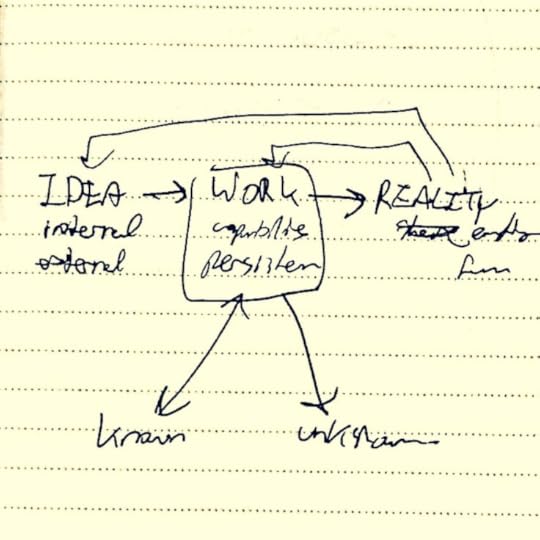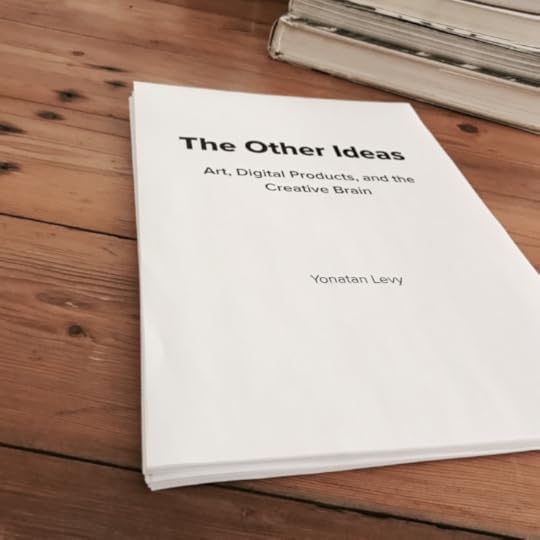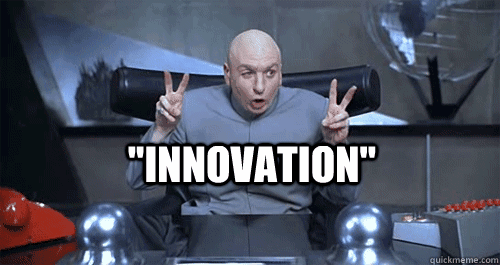Yonatan Levy's Blog
December 13, 2017
Uncertainty is not the enemy

Leading innovation agencies offer processes for systematically reducing uncertainty and risk, as a key to take companies to their next level. They blast social media with graphs and models to support these concepts. But that’s missing the point, because it doesn’t matter how hard we try to avoid it, uncertainty will always come our way.
Market trends, unexpected circumstances and the volatile tech landscape will always catch us unprepared. Trying to get rid of uncertainty, is like running a marathon without getting tired. It’s impossible of course. The truth is uncertainty will always be there, no matter how experienced we are or which methods we use.
So I believe we need to take it one step further, by learning to dance with uncertainty, instead of trying to avoid it. The real question is — how can we embrace uncertainty and use it as a tool to reach higher levels of creativity, especially when we are inherently wired to avoid it?
If we only learn to harness uncertainty to our advantage, we can accelerate our creative and inventive abilities to levels we never thought possible. How? By getting to know it, expecting it, and changing the way we think about it.
We don’t need to seek to be confident all the time. Rather, we’re better off acknowledging the self-doubt, fear, and anxiety, that stem from uncertainty — then push past them as we continue to do meaningful work and take decisions.
When we hear the voice of angst shouting, it’s a sure sign that we’re leaving our comfort zone—the realm of certainty—and moving toward our more creative mental states. In essence, our fear is a positive indicator, one that we must learn to embrace, not shirk away from.
Using uncertainty as a tool is an acquired skill, and not at all dependent on talent or “special” abilities. It’s a skill that, through a methodical approach, can be practiced and improved upon. In my new book titled The Other Ideas: Art, Digital Products and the Creative Brain, I discuss this practice in depth.
By trying to avoid risk, we expose ourselves to a much greater risk of getting stuck, and gradually becoming less relevant and getting pushed out of the game. The enemy is not uncertainty - the real enemy is stagnation.
Yonatan Levy is a product leader, entrepreneur, artist. Author of The Other Ideas, Art, Digital Products, and the Creative Mind and blogs about innovation, digital transformation, and product management.

Uncertainty is not the enemy was originally published in The Other Ideas on Medium, where people are continuing the conversation by highlighting and responding to this story.
November 19, 2017
The mistake we make about creative work

The mistake we make about creative work, is that we do what we set out to do.
Why is it a mistake? Because also machines can do the exact same thing — execute a configured task. Machines can even randomize actions, and consolidate an unexpected outcome.
If we don’t keep our human advantage by following serendipitous triggers that spark our curiosity, then what have we got left? There’s a great creative potential in trying things along the way that might not work.
There’s an immense power in *not* panicking in the face of uncertainty — because it’s an essential ingredient for a meaningful journey, not a by-product.
What about the result? It might turn out different than what we initially intended — but at least it’s special, it might touch people who will spread the word and tell their friends about it. Besides, the uncertain journey is where all the fun is.
So if we do what we set out to do, then why do it? Let’s emphasize our human touch , including the hesitations and imperfections in our work. Let’s not imitate a machine. Let’s turn our work into art. Because it’s not what we see that matters, it’s what we don’t see yet that makes a difference.
Yonatan Levy is a product leader, entrepreneur, artist. Author of The Other Ideas, Art, Digital Products, and the Creative Mind and blogs about innovation, product management, digital transformation.

The mistake we make about creative work was originally published in The Other Ideas on Medium, where people are continuing the conversation by highlighting and responding to this story.
November 13, 2017
Why I wrote a book

I didn’t set out to write a bestseller, and never intended to be an author. I wrote my book simply because I had something to share, and I believed it could touch people.
It’s related to what I’ve been exploring for years and still fascinates me today. It’s about an approach, a way to look at the world with genuine curiosity, sharpened focus, and a relentless drive to champion new ideas and fight the mundane.
For me, writing is not a means of achieving a goal — I’m not worried about how many words I write or total page count. Rather, writing is a tool to capture what I’m thinking. When I write, all my attention goes to the writing activity itself and the thoughts it provokes.
Everyone is creativeOver the last decade, as a product leader, user-experience expert, and entrepreneur, I came to realize that everyone is creative, but that some people can access their creative thinking more easily than others. My own experience has taught me that there’s no mystery to tapping into “the creative zone,” no magical formula needed: it’s simply a matter of fostering the right circumstances for creativity to flourish.
In all product leadership positions that I’ve held, no matter my specific role or title, research into invention and problem solving is always fundamental to my work. The thinking process is something that we all can experience for ourselves, but we can’t always follow the exact reasons why sometimes we get good results, while we miserably fail at other attempts . For this I strive to describe my findings in clear, simple language that’s accessible to everyone.
My originMy introduction to creative thinking and problem solving first began while I was a fine arts student, well before I entered the high-tech world. In art school, I continually faced creative challenges that were immensely time consuming and demanding. Short assignment deadlines often lit a fire under me, and having my work constantly (and relentlessly) critiqued by renowned contemporary artists only fueled those flames. For four long years, each of my artistic assignments was a “problem,” and I had to call on my own creativity to “solve” it.
 Notes I took 3 years ago, that would later become The Other Ideas book.
Notes I took 3 years ago, that would later become The Other Ideas book.By the time I graduated, I had figured out that traditional art was limiting my ability to reach large audiences quickly and independently. I wanted to explore a whole new canvas — the Internet — and was increasingly interested in the “new art” of delivering meaningful digital products and services into the hands of huge audiences. That’s what led me to launch my first tech start-up in 2007, which focused on detecting and analyzing online trends.
I loved building products and fitting them to markets, but as the years progressed, I became engrossed by one overarching paradox: How could product developers and entrepreneurs, who practically worshiped at the altar of innovation, also be so clearly afraid of change?
Copycatting was rampant in the industry; I had seen smart and talented entrepreneurs and product managers make the same “safe” choices — and ultimately the same safe products — over and over again. Had we grown so risk-averse that the safety of certainty and predictability now outweighed the excitement and potential of fresh, bold ideas?
These questions became the foundation of my product management approach. Over time, they turned out to be the key to unlocking my career potential, as I managed to deliver a slew of successful digital products for companies both big and small.
Incorporating art into business and techI’m no innovation guru, and I don’t have a success formula to offer. But I do hope that people can benefit from my multidisciplinary (and sometimes surprising) journey: I began gathering my artistic and creative approaches, problem-solving skills, and accumulated tech industry experience into one book, with the goal of helping others harness their own personal ingenuity.
 Final draft of The Other Ideas.
Final draft of The Other Ideas.Published in 2017, The Other Ideas: Art, Digital Products, and the Creative Mind, reflects over two years of writing and dedication. I hope that my work will help others learn how to translate abstract thinking into measurable deliverables and breakthrough digital products. We have a huge opportunity in our hands: to create meaningful impact in the digital disruption age we live in. Even more than that, I hope my readers will use the insights in The Other Ideas to enrich their personal lives as well.
Yonatan Levy is a product leader, entrepreneur, artist. Author of The Other Ideas, Art, Digital Products, and the Creative Mind and blogs about innovation, product management, digital transformation.

Why I wrote a book was originally published in The Other Ideas on Medium, where people are continuing the conversation by highlighting and responding to this story.
October 30, 2017
Welcome to a world of accelerated technology disruption

Look around — technology disruption is accelerating. We’re in 4th gear, heading to 5th. Stable and profitable industries are being put out of business by innovative technologies and determined entrepreneurs.
Remember the days when Microsoft was the evil empire, squashing new software companies? Flash forward 20 years later to today and the evil empire is complacency.A blockbuster movie experience
In the 1990s, Blockbuster had a winning business model. I remember visiting Key West and stopping at a Blockbuster to get a few movies to watch at a beachfront condo. On Sunday nights in many US cities and towns, Blockbuster was a “community center” where you met and mingled with your neighbors.
By the late 1990’s, it was obvious where things were going, but Blockbuster executives were convinced that people loved going to their stores and that it would never end. Within a few years, they were disrupted by Netflix, YouTube and other video streaming services.
Today, there are only 11 Blockbuster branches in the US, 7 of which are in Alaska, where broadband internet is expensive.
What could Blockbuster have done? The chain should have redefined itself as a “content distributor” and let go of the a “brick and mortar content distributor” model. Like many failed businesses in the past decade, they didn’t take internet disruption seriously.
Looking back, it’s funny to think, “Oh yeah, at night when I want to watch a movie, I will get dressed, get in the car, and drive to a store to find out that the movie I really want to see is already rented out. And, if I don’t return the video on time, they fine me!”
Super Uber to the rescue!When you hear the word “taxi”, you shrug. For decades, riders put up with awful service with no ability to fix things. When you called a dispatcher — whether in New York or London or anywhere else — complaining about a rude driver, you were ignored or given lip service.
Taxi drivers saved hundreds of thousands of dollars — or more — to get their coveted taxi license. At the same time, they invested $0 and zero time in improving how they treated customers and on efficiency. The taxi business was as grey and mediocre as they get. “Taxi” was the polar opposite of “innovation”.
Today, Uber is getting us to airports and meetings faster and with a much better “user experience” than the dinosaur yellow taxis. The Uber cars are light years ahead of New York City’s yellow taxis. Better yet, the drivers actually care that you have a pleasant experience.
Who wants to call a taxi phone number, or stand waiting in the rain, when you can just open an app? Did your previous taxi company ever ask you to rate the driver?
The fall of the traditional music industryI remember going from vinyl and 8-tracks to cassettes and finally to cd’s. I spent a lot of my money on “upgrading to cd” in high school and in the years after. In those days, the music industry ran the show.
By 2002 mp3s and file sharing became huge and torrent sites were starting to flourish. Peak sales were down, and it was obvious something big was happening. The average person knew people who had music collections on their computer and the first wave of music store closings had begun.
What did the the music industry executives do? Nothing. They refused to see the writing on the wall and innovate, and remained in the tunnel vision of certainty. They took zero risks, expected the world to return to the way it once was, and they lost.
What Happens to a Risk Averse Industry When Disruption Hits?
Toys-R-Us and the American MallThe American Mall — may you rest in peace. Like Blockbuster, Toys-R-Us and many other large American retailers believed their own fables.
In 2000 Toys-R-Us signed a 10 year agreement with Amazon to be the exclusive vendor of toys on Amazon, Forbes reports. But ruthless Amazon allowed other toy vendors to sell on its site in spite of the deal, and Toys-R-Us sued Amazon to end the agreement in 2004.
Instead of reinventing themselves as the tech company, Toys-R-Us signed a contract that led to their demise. Toys-R-Us missed the opportunity to develop their own e-commerce presence early on and ultimately filed for Chapter 11 bankruptcy protection in the US and Canada.
Toys-R-Us assumed they can rely on consumers enjoying the “in-store experience” as a meetup place for moms and neglected the web. While Amazon, a small niche book store in those days, saw the future — “one click purchasing!”
Amazon sells “everything” — toys, games, movies, clothes, furniture — and now food, thanks to their buyout of Whole Foods. Software is now the top of the pyramid and retailers are under Amazon and eBay’s umbrella, like it or not.
How Supermarkets Fell into Amazon’s Trap
An Era of Accelerated DisruptionThe above examples — and many more — lead us to one conclusion: We are living in an era of accelerated technology disruption.
Nothing in business is sacred. What seems like a solid business model can be disrupted in a matter of months. Product managers and CTO’s don’t have the luxury of years to figure things out, it’s all about moving fast, very fast.
In a sense, time is accelerated. You might rest on your laurels briefly, but by the time you wake up, your business can be “Ubered” or “Amazoned”.How Can You Avoid Technology Disruption?
When you’re riding high — be careful. Giants fall hard when they are at their peak of profits. Everything was fine for Blockbuster, Toys-R-Us and many other American retailers — until it wasn’t.
Disrupt your business. Don’t wait for a competitor to do the dirty work. Do it yourself. Consider this every day — “How can we disrupt our own business?” You may not be thinking this, but I guarantee your future competitors are.
In a dynamic world, the “safe path” might turn into a risky one. When was the last time you took risk and made a leap forward? What can you do today to secure your market for the long run?
Yonatan Levy is a product leader, entrepreneur, artist. Author of the The Other Ideas: Art, Digital Products, and the Creative Mind
Enjoyed the post? Please feel free to share + give this pieceOctober 25, 2017
How to set up your company for innovation

An amazing change is happening in the way we think about work and management. Companies today are operating in a completely different world compared to the business landscape of the last decades. As new needs emerge we discover that traditional management tools and corporate structures do not provide for the evolving challenges.
Today’s companies need to move very fast, deal with uncertainty, and respond to a rapidly changing landscape more than ever before.
Embracing these new approaches is crucial for keeping up to speed with today’s tech landscape:
Flat organizational structureThe traditional chain of command is too slow — by the time we get the approvals necessary we could have already tested our idea on real users and come back with meaningful insights.
Our products are continuously delivered as tiny bits of code into our customers hands. Professional teams should be authorized to deploy code independently, learn and improve, in order to move towards a common goal. There’s no time for a long list of approvals, it’s way too slow.
Radical transparencyCEO’s and entrepreneurs can no longer be regarded as the ones who know and decide everything. Today’s leaders understand the importance of relying on the variety of perspectives and skills of their teams in order to evolve and succeed.
This requires two things. First, we need to have the people inside the organization who have a voice and a grit to say “wait a minute, I think we should be doing it this way…”. People who are thinking of ways that their organization could get disrupted, before somebody else does.
If I were my competitor, how would I put myself out of business?
Second, managers must find the humility to deal with a direct, non hierarchical ecosystem. CEOs of the new breed must build organizations that empower employees to experiment, exchange knowledge and try things that might not work. Platforms are needed through which employees can provide candid feedback, and express their opinions safely.
Ray Dalio introduces in Principles, his new book, the concept of idea meritocracy — which encourages surfacing diverse ideas, and enables the best ones to win. He has implemented this approach to build Bridgewater to become the most successful hedge fund in the world.
Collaborative problem solvingAs our industry moves from linear models to agile software deployment, we are forced to rethink the way we solve problems and take decisions. In the old model each department would be responsible to solve their own problem, and then pass on the project to the next department to deal with the next problems in line.
Today’s leaders must solve problems by involving multidisciplinary teams — product mangers, engineers, data scientists, and designers — to solve problems together in iterative cycles. When implemented effectively, collaborative problem solving can become a core mechanism by which people connect towards a common goal and foster a culture of innovation.
The future belongs to creatorsThere is less need for managers who instruct others what to do, and more need for great craftspeople, creators, and entrepreneurs — who can take an idea, make something real out of it, and inform the team of their findings.
Don’t waste a chance of a lifetime — take the opportunity to step up your game.
The old game is not enough anymore. Whether you are a developer, marketer, product manager or designer, we need to be able to master our craft and bring our grit to the forefront. We must be ready to try new things and fail. This is what real artists do.
[ Yonatan Levy is a product leader, entrepreneur, artist. Author of the The Other Ideas: Art, Digital Products, and the Creative Mind ]
Enjoyed the post? Please feel free to share + give this pieceOctober 17, 2017
This week’s must-reads: How to Encourage Entrepreneurial Risk Tolerance
“Invention is not disruptive. Only customer adoption is disruptive.” — Jeff Bezos
 INNOVATION
INNOVATIONIf you don’t ship it, how can you make it better? Every time we launch a new project there is this moment of concern — what if it doesn’t work? Why is it important to try, and how can it help us?
Behind the Scenes: How Ideas Are Transformed into Productive Work. Turning ideas into practical solutions at work is a huge mountain to climb. We feel good when it happens, but do we really understand the process for making it happen over and over again on our demand?
Want to be a better innovator? Master this one skill. Today’s tech landscape is based on uncertainty, and held together by embracing change. Companies understand that by voiding risks, they expose themselves to a much greater risk: getting disrupted.
DISRUPTIONHow Supermarkets Fell into Amazon’s Trap. The stagnating supermarket industry is in for a rude awakening. Why did they stop evolving and what could they have done about it?
What Happens to a Risk Averse Industry When Disruption Hits? The Fall of the Traditional Music Industry. In the past decade, the music industry has shifted from physical consumer products to digital ones, and most traditional record companies have not survived the change. If those companies would have taken more risks and embraced change, it might have ended differently.
Take Risks or Be Disrupted — How to Encourage Risk Tolerance in Product Management. About entrepreneurial risk-tolerance. And how a dynamic world can turn the “safe path” into a risky one.
The Other Ideas is all about championing new ideas and fighting the mundane — thoughts on art, invention, disruption and product management. I’ve also published a NEW book by the same name check it out here.
Liked the links? Please feel free to share + give this pieceThe importance of taking risks and shipping your work — even if it’s unfinished
“Invention is not disruptive. Only customer adoption is disruptive.” — Jeff Bezos
 If you don’t ship it, how can you make it better? →
If you don’t ship it, how can you make it better? →Every time we launch a new project there is this moment of concern — what if it doesn’t work? Why is it important to try, and how can it help us?
Take Risks or Be Disrupted — How to Encourage Risk Tolerance in Product Management →About entrepreneurial risk-tolerance. And how a dynamic world can turn the “safe path” into a risky one.
Behind the Scenes: How Ideas Are Transformed into Productive Work →Turning ideas into practical solutions at work is a huge mountain to climb. We feel good when it happens, but do we really understand the process for making it happen over and over again on our demand?
How Supermarkets Fell into Amazon’s Trap →The stagnating supermarket industry is in for a rude awakening. Why did they stop evolving and what could they have done about it?
What Happens to a Risk Averse Industry When Disruption Hits? The Fall of the Traditional Music Industry →In the past decade, the music industry has shifted from physical consumer products to digital ones, and most traditional record companies have not survived the change. If those companies would have taken more risks and embraced change, it might have ended differently.
Liked the links? Please click theOctober 15, 2017
Ship it — even if you’re embarrassed

Being a creator does not mean doing whatever is on our minds. It means doing something people care about. If we make something that doesn’t touch anyone, that people can’t relate to, then what have we done? Did we really create something if only we can see it?
“Invention is not disruptive. Only customer adoption is disruptive.” — Jeff Bezos
Any creation needs to have an impact. It must reach out, touch people and open a door for others to come in — and we’ll never know if it works unless we try.
Creating is not only about creative thinking, it’s about trying stuff and shipping products continuously to see how people respond — even at stages when we still have doubts about it. Especially when we have doubts — ship constantly.
Ship even if it doesn’t work quite right yet.
Ship even if you’re slightly embarrassed.
Just ship the damn thing and the next idea will come.
The main reason we’re always better off shipping our unfinished work is that it ends up helping us. Sharing our work, even in its roughest stages, will be a surefire way of better understanding a problem, making room for a new and broader spectrum of ideas, thoughts, possibilities and — in the long run — steering us toward our market fit.
I’ve always felt this is the way it should be, and as a product manager and a creator, I have done so myself throughout my career. In the past two years I have been through a wonderful journey, that ended with shipping a new experiment (because it’s always an experiment). It’s a book titled The Other Ideas: Art, Digital Products and the Creative Mind, about turning uncertainty it into inventive power and integrating artistic methods in the work we do.
It’s only now, a few months after I’ve shipped the first version and people have read it, that I begin to really understand what I’ve written. Shipping it prematurely made an amazing and significant change to the book. It led to a 2nd edition, which is far better than the 1st one — with more content, more examples, more guidance.
I couldn’t have done this huge improvement without shipping it early and letting my readers inform me of what works and what doesn’t.
When was the last time you shipped unfinished work? How did it effect your next steps? Was it worth it? Please go ahead and comment:)
Thanks for reading!Ship — even if you’re embarrassed

Being a creator does not mean doing whatever is on our minds. It means doing something people care about. If we make something that doesn’t touch anyone, that people can’t relate to, then what have we done? Did we really create something if only we can see it?
“Invention is not disruptive. Only customer adoption is disruptive.” — Jeff Bezos
Any creation needs to have an impact. It must reach out, touch people and open a door for others to come in — and we’ll never know if it works unless we try.
Creating is not only about creative thinking, it’s about trying stuff and shipping products continuously to see how people respond — even at stages when we still have doubts about it. Especially when we have doubts — ship constantly.
Ship even if it doesn’t work quite right yet.
Ship even if you’re slightly embarrassed.
Just ship the damn thing and the next idea will come.
The main reason we’re always better off shipping our unfinished work is that it ends up helping us. Sharing our work, even in its roughest stages, will be a surefire way of better understanding a problem, making room for a new and broader spectrum of ideas, thoughts, possibilities and — in the long run — steering us toward our market fit.
I’ve always felt this is the way it should be, and as a product manager and a creator, I have done so myself throughout my career. In the past two years I have been through a wonderful journey, that ended with shipping a new experiment (because it’s always an experiment). It’s a book titled The Other Ideas: Art, Digital Products and the Creative Mind, about turning uncertainty it into inventive power and integrating artistic methods in the work we do.
It’s only now, a few months after I’ve shipped the first version and people have read it, that I begin to really understand what I’ve written. Shipping it prematurely made an amazing and significant change to the book. It led to a 2nd edition, which is far better than the 1st one — with more content, more examples, more guidance.
I couldn’t have done this huge improvement without shipping it early and letting my readers inform me of what works and what doesn’t.
When was the last time you shipped unfinished work? How did it effect your next steps? Was it worth it? Please go ahead and comment:)
Thanks for reading!Ship your work, even if it’s not finished yet

Being a creator does not mean doing whatever is on our mind. It means doing something people care about. If we make something that doesn’t touch anyone, that people can’t relate to, then what have we done? Did we really create something if only we can see it?
“Invention is not disruptive. Only customer adoption is disruptive.” — Jeff Bezos
Any creation needs to have an impact. It must reach out, touch people and open a door for others to come in — and we’ll never know if it works unless we try.
Creating is not only about creative thinking, it’s about trying stuff and shipping products continuously to see how people respond — even at stages when we still have doubts about it. Especially when we have doubts — ship constantly.
Ship even if it doesn’t work quite right yet.
Ship even if you’re slightly embarrassed.
Just ship the damn thing and the next idea will come.
The main reason we’re always better off shipping our unfinished work is that it ends up helping us. Sharing our work, even in its roughest stages, will be a surefire way of better understanding a problem, making room for a new and broader spectrum of ideas, thoughts, possibilities and — in the long run — steering us toward our market fit.
I’ve always felt this is the way it should be, and as a product manager and a creator, I have done so myself throughout my career. In the past two years I have been through a personal journey, that ended with shipping a new experiment (because it’s always an experiment). It’s a book titled The Other Ideas: Art, Digital Products and the Creative Mind, about harnessing uncertainty and transforming it into creative power.
It’s only now, a few months after I’ve shipped the first version, and people have read it, that I begin to really understand what I’ve written. Shipping it prematurely made an amazing and significant change to the book.
Leading to the 2nd edition, which is far better than the 1st one — with more content, more examples, more guidance. I couldn’t have done this leap forward without shipping it earlier and letting my readers inform me of what works and what doesn’t.
When was the last time you shipped unfinished work? How did it effect your next steps? Was it worth it? Please go ahead and comment:)
Thanks for reading!


